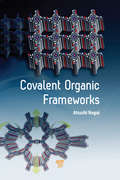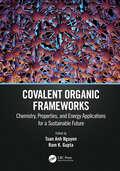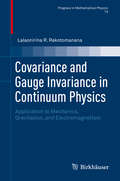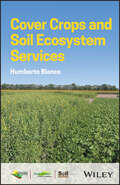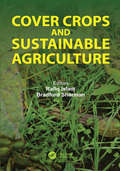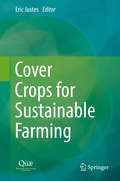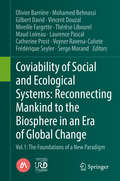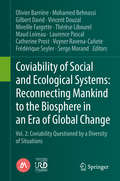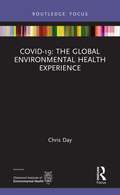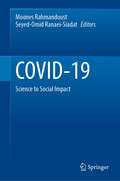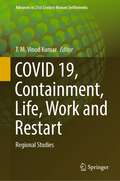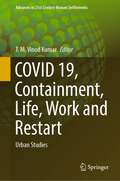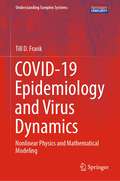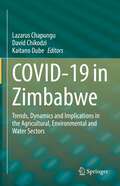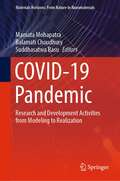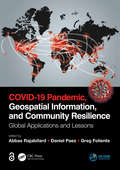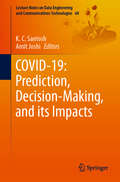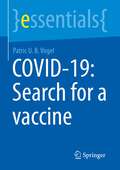- Table View
- List View
Covalent Organic Frameworks
by Atsushi NagaiRational synthesis of extended arrays of organic matter in bulk, solution, crystals, and thin films has always been a paramount goal of chemistry. The classical synthetic tools to obtain long-range regularity are, however, limited to noncovalent interactions, which usually yield structurally more random products. Hence, a combination of porosity and regularity in organic covalently bonded materials requires not only the design of molecular building blocks that allow for growth into a nonperturbed, regular geometry but also a condensation mechanism that progresses under reversible, thermodynamic, self-optimizing conditions. Covalent organic frameworks (COFs), a variety of 2D crystalline porous materials composed of light elements, resemble an sp2-carbon-based graphene sheet but have a different molecular skeleton formed by orderly linkage of building blocks to constitute a flat organic sheet. COFs have attracted considerable attention in the past decade because of their versatile applications in gas storage and separation, catalysis, sensing, drug delivery, and optoelectronic materials development. Compared to other porous materials, COFs allow for atomically precise control of their architectures by changing the structure of their building blocks, whereby the shapes and sizes of their pores can be well-tuned. Covalent Organic Frameworks is a compilation of different topics in COF research, from COF design and synthesis, crystallization, and structural linkages to the theory of gas sorption and various applications of COFs, such as heterogeneous catalysts, energy storage (e.g., semiconductors and batteries), and biomedicine. This handbook will appeal to anyone interested in nanotechnology and new materials of gas adsorption and storage, heterogeneous catalysts, electronic devices, and biomedical devices.
Covalent Organic Frameworks
by Atsushi NagaiRational synthesis of extended arrays of organic matter in bulk, solution, crystals, and thin films has always been a paramount goal of chemistry. The classical synthetic tools to obtain long-range regularity are, however, limited to noncovalent interactions, which usually yield structurally more random products. Hence, a combination of porosity and regularity in organic covalently bonded materials requires not only the design of molecular building blocks that allow for growth into a nonperturbed, regular geometry but also a condensation mechanism that progresses under reversible, thermodynamic, self-optimizing conditions. Covalent organic frameworks (COFs), a variety of 2D crystalline porous materials composed of light elements, resemble an sp2-carbon-based graphene sheet but have a different molecular skeleton formed by orderly linkage of building blocks to constitute a flat organic sheet. COFs have attracted considerable attention in the past decade because of their versatile applications in gas storage and separation, catalysis, sensing, drug delivery, and optoelectronic materials development. Compared to other porous materials, COFs allow for atomically precise control of their architectures by changing the structure of their building blocks, whereby the shapes and sizes of their pores can be well-tuned. Covalent Organic Frameworks is a compilation of different topics in COF research, from COF design and synthesis, crystallization, and structural linkages to the theory of gas sorption and various applications of COFs, such as heterogeneous catalysts, energy storage (e.g., semiconductors and batteries), and biomedicine. This handbook will appeal to anyone interested in nanotechnology and new materials of gas adsorption and storage, heterogeneous catalysts, electronic devices, and biomedical devices.
Covalent Organic Frameworks: Chemistry, Properties, and Energy Applications for a Sustainable Future
by Tuán Anh Nguyen Ram K. GuptaCovalent organic frameworks-based nanomaterials have emerged as promising candidates for energy applications owing to their superior electrochemical properties, surface area, nano-device integration, multifunctionality, printability, and mechanical flexibility. This book provides fundamentals, various synthesis approaches, and applications of covalent organic frameworks-based nanomaterials and their composites for generating energy. The main objective of this book is to provide current, state-of-the-art knowledge about covalent organic frameworks-based nanomaterials and their composites for supercapacitors, batteries, photovoltaics, and fuel cells, covering almost the entire spectrum in the energy field under one title. Aimed at widening our fundamental understanding of covalent organic frameworks and mechanisms for realization and advancement in devices with improved energy efficiency and high storage capacity, this book will provide new directions for scientists, researchers, and students to better understand the principles, technologies, and applications of covalent organic frameworks.
Covalent Organic Frameworks: Chemistry, Properties, and Energy Applications for a Sustainable Future
by Tuan Anh Nguyen Ram K. GuptaCovalent organic frameworks-based nanomaterials have emerged as promising candidates for energy applications owing to their superior electrochemical properties, surface area, nano-device integration, multifunctionality, printability, and mechanical flexibility. This book provides fundamentals, various synthesis approaches, and applications of covalent organic frameworks-based nanomaterials and their composites for generating energy. The main objective of this book is to provide current, state-of-the-art knowledge about covalent organic frameworks-based nanomaterials and their composites for supercapacitors, batteries, photovoltaics, and fuel cells, covering almost the entire spectrum in the energy field under one title. Aimed at widening our fundamental understanding of covalent organic frameworks and mechanisms for realization and advancement in devices with improved energy efficiency and high storage capacity, this book will provide new directions for scientists, researchers, and students to better understand the principles, technologies, and applications of covalent organic frameworks.
Covariance and Gauge Invariance in Continuum Physics: Application to Mechanics, Gravitation, and Electromagnetism (Progress in Mathematical Physics #73)
by Lalaonirina R. RakotomananaThis book presents a Lagrangian approach model to formulate various fields of continuum physics, ranging from gradient continuum elasticity to relativistic gravito-electromagnetism. It extends the classical theories based on Riemann geometry to Riemann-Cartan geometry, and then describes non-homogeneous continuum and spacetime with torsion in Einstein-Cartan relativistic gravitation. It investigates two aspects of invariance of the Lagrangian: covariance of formulation following the method of Lovelock and Rund, and gauge invariance where the active diffeomorphism invariance is considered by using local Poincaré gauge theory according to the Utiyama method. Further, it develops various extensions of strain gradient continuum elasticity, relativistic gravitation and electromagnetism when the torsion field of the Riemann-Cartan continuum is not equal to zero. Lastly, it derives heterogeneous wave propagation equations within twisted and curved manifolds and proposes a relation between electromagnetic potential and torsion tensor.
Cover Crops and Soil Ecosystem Services (ASA, CSSA, and SSSA Books #196)
by Humberto BlancoCover Crops and Soil Ecosystem Services A comprehensive resource on cover crops and their role in soil ecosystems Cover crops are a reemerging strategy to improve and maintain the services that soils provide. They can have an enormous affect on agricultural outcomes, preventing soil erosion, restoring vital soil nutrients, sequestering C from the atmosphere, and more. The successful management and use of cover crops is therefore critical to ensure soil ecosystem services are maintained or improved not only to meet our demands for food, fuel, fiber, and feed but also to reduce pollution and improve the soil. Cover Crops and Soil Ecosystem Services provides a heavily researched and highly readable introduction to cover crops and their role in soil ecosystems. It ranges from a detailed discussion of cover crop biomass production to a thorough treatment of soil ecosystems and their vulnerabilities. The result is an essential guide to a critical area of agricultural science. Cover Crops and Soil Ecosystem Services readers will also find: Detailed treatment of cover crop biomass production, soil erosion, greenhouse gas fluxes, nitrate leaching, soil C sequestration, and more Discussion of emerging issues, including extreme weather events and the economics of cover crop farming Wide-ranging summaries of interdisciplinary soil and cover crop research Cover Crops and Soil Ecosystem Services is a useful reference for students and researchers at all levels of study relating to cover crop agriculture.
Cover Crops and Soil Ecosystem Services (ASA, CSSA, and SSSA Books #196)
by Humberto BlancoCover Crops and Soil Ecosystem Services A comprehensive resource on cover crops and their role in soil ecosystems Cover crops are a reemerging strategy to improve and maintain the services that soils provide. They can have an enormous affect on agricultural outcomes, preventing soil erosion, restoring vital soil nutrients, sequestering C from the atmosphere, and more. The successful management and use of cover crops is therefore critical to ensure soil ecosystem services are maintained or improved not only to meet our demands for food, fuel, fiber, and feed but also to reduce pollution and improve the soil. Cover Crops and Soil Ecosystem Services provides a heavily researched and highly readable introduction to cover crops and their role in soil ecosystems. It ranges from a detailed discussion of cover crop biomass production to a thorough treatment of soil ecosystems and their vulnerabilities. The result is an essential guide to a critical area of agricultural science. Cover Crops and Soil Ecosystem Services readers will also find: Detailed treatment of cover crop biomass production, soil erosion, greenhouse gas fluxes, nitrate leaching, soil C sequestration, and more Discussion of emerging issues, including extreme weather events and the economics of cover crop farming Wide-ranging summaries of interdisciplinary soil and cover crop research Cover Crops and Soil Ecosystem Services is a useful reference for students and researchers at all levels of study relating to cover crop agriculture.
Cover Crops and Sustainable Agriculture
by Rafiq Islam Bradford ShermanThis book will not serve as the "encyclopedia of cover crop management," but it’s close. The benefits of a wide range of individual cover crops and blends/mixes for specific agronomic crop rotations and geographic locations are included. Descriptions, photographs, and illustrations show how cover crops look in the field, including plant height, leaf architecture, and rooting patterns. Long term benefits are described for soil health, soil structure, water quality, nutrient contributions, soil biodiversity, air quality and climate change. In addition to the "whys" of cover crop use, the book includes details on the "hows:" how to choose cover crops for specific applications and locations; how (and when) to plant; how to manage and maintain the cover for maximum benefit; and how and when to terminate. Planting options include: drilling/planting between rows of an agronomic crop at planting time, or when the crop is short (i.e. corn in early June); "aerial" seeding with an airplane or high-clearance machine shortly before the crop reaches maturity; and drilling/planting immediately after harvest of the agronomic crop. Selected cover crops (blends) can help with pest and disease management. Cover crops are an economic input with an expected return on investment, similar to pesticides and fertilizer. As part of a continuous no-till system, cover crops provide long-term biological, chemical and structural benefits. The resulting increase in soil organic matter means the agronomic crop yields benefit from better water infiltration and water holding capacity, greater availability of nitrogen and other nutrients, deeper rooting, and increased soil microbial activity in the root zone.
Cover Crops and Sustainable Agriculture
by Rafiq Islam and Bradford ShermanThis book will not serve as the "encyclopedia of cover crop management," but it’s close. The benefits of a wide range of individual cover crops and blends/mixes for specific agronomic crop rotations and geographic locations are included. Descriptions, photographs, and illustrations show how cover crops look in the field, including plant height, leaf architecture, and rooting patterns. Long term benefits are described for soil health, soil structure, water quality, nutrient contributions, soil biodiversity, air quality and climate change. In addition to the "whys" of cover crop use, the book includes details on the "hows:" how to choose cover crops for specific applications and locations; how (and when) to plant; how to manage and maintain the cover for maximum benefit; and how and when to terminate. Planting options include: drilling/planting between rows of an agronomic crop at planting time, or when the crop is short (i.e. corn in early June); "aerial" seeding with an airplane or high-clearance machine shortly before the crop reaches maturity; and drilling/planting immediately after harvest of the agronomic crop. Selected cover crops (blends) can help with pest and disease management. Cover crops are an economic input with an expected return on investment, similar to pesticides and fertilizer. As part of a continuous no-till system, cover crops provide long-term biological, chemical and structural benefits. The resulting increase in soil organic matter means the agronomic crop yields benefit from better water infiltration and water holding capacity, greater availability of nitrogen and other nutrients, deeper rooting, and increased soil microbial activity in the root zone.
Cover Crops for Sustainable Farming
by Eric JustesThis study, based on a literature review and simulations, shows the efficiency of cover crops at catching nitrate in most agriculture situations. It also analyzes both the negative impacts they can have and the ecosystem services they can provide. The introduction of a cover crop between two main crops helps catch the soil mineral nitrogen before the period of drainage and consequently reduces nitrate leaching and nitrate concentration in the drainage water. This study allows quantifying the efficiency of cover crops at catching nitrate and optimizing their implantation conditions over a large range of French pedoclimatic conditions. The presence of high nitrate levels in surface and ground waters, due to excessive nitrogen fertilization and natural production of nitrate by soil organic matter mineralization, is a double challenge for public health and environment protection.
Covered Bridges in China
by China Highway &Transportation SocietyThis book is the first comprehensive work on Chinese covered bridges study, covering fields of human geography, historical buildings, and transportation. It includes more than 300 covered bridges of ancient and modern China, researching and analyzing their historical evolutions, architectural technologies and aesthetic values. And it, for the first time, divides Chinese covered bridges into “six covered bridge belts” and fills the academic gaps. This book presents an informative and splendid tour into covered bridges, illustrated and full of humanist consciousness. It targets on audience who works in transportation, human geography, historical buildings and Chinese traditional culture with its significant value both in academy and art.
Coviability of Social and Ecological Systems: Vol.1 : The Foundations of a New Paradigm
by Serge Morand Mohamed Behnassi Olivier Barrière Gilbert David Vincent Douzal Mireille Fargette Thérèse Libourel Maud Loireau Laurence Pascal Catherine Prost Voyner Ravena-Cañete Frédérique SeylerThis book considers the principle of ‘sustainable development’ which is currently facing a growing environmental crisis. A new mode of thinking and positioning the ecological imperative is the major input of this volume. The prism of co-viability is not the economics of political agencies that carry the ideology of the dominant/conventional economic schools, but rather an opening of innovation perspectives through science. This volume, through its four parts, more than 40 chapters and a hundred authors, gives birth to a paradigm which crystallizes within a concept that will support in overcoming the ecological emergency deadlock.
Coviability of Social and Ecological Systems: Vol. 2: Coviability Questioned by a Diversity of Situations
by Olivier Barrière Mohamed Behnassi Gilbert David Vincent Douzal Mireille Fargette Thérèse Libourel Maud Loireau Laurence Pascal Catherine Prost Voyner Ravena-Cañete Frédérique Seyler Serge MorandThis second volume is the work of more than 55 authors from 15 different disciplines and includes complex systems science which studies the viability of components, and also the study of empirical situations. As readers will discover, the coviability of social and ecological systems is based on the contradiction between humanity, which adopts finalized objectives, and the biosphere, which refers to a ecological functions. We see how concrete situations shed light on the coviability’s determinants, and in this book the very nature of the coviability, presented as a concept-paradigm, is defined in a transversal and ontological ways. By adopting a systemic approach, without advocating any economic dogma (such as development) or dichotomizing between humans and nature, while emphasizing what is relevant to humans and what is not, this work neutrally contextualizes man’s place in the biosphere. It offers a new mode of thinking and positioning of the ecological imperative, and will appeal to all those working with social and ecological systems.
COVID-19: The Global Environmental Health Experience (Routledge Focus on Environmental Health)
by Chris DayThis book is devoted to the efforts of Environmental Health Practitioners (EHPs), their employers and supportive professional bodies world-wide in responding to the COVID-19 pandemic. Drawing upon the first-hand experiences and reflections of EHPs working across the professional discipline in countries around the world, the book highlights how they responded to the initial wave of SARS-CoV-2 infection as it spread globally. It explores how this impacted on their environmental health work as their wider public health skills and expertise were increasingly called upon/ The book recognises the significant contributions that EHPs have made to protect lives and livelihoods since the seriousness of COVID-19 became apparent. It also identifies shortcomings in the response and deployment of personnel and makes a series of recommendations to inform future practice. This book: Captures a moment in history through the experiences of Environmental Health Practitioners in meeting the complex challenges presented by the COVID-19 pandemic. Features the observations of front line practitioners on the practical challenges and opportunities encountered globally, suggesting the lessons learnt for current practice in infectious disease prevention and control. Expands upon the reflections of some of the professional bodies around the world as to how the response of EHPs to the COVID-19 pandemic should result in a renewed commitment to public health through Environmental Health. EHPs in current practice and in training, other public health professionals and those looking to build better health protection services, now, and in the future, will find this book a valuable resource to inform the case for the key role of Environmental Health in the current pandemic, in response to future challenges and crises, and in managing risks to health encountered in more usual times.
COVID-19: Science to Social Impact
by Moones Rahmandoust Seyed-Omid Ranaei-SiadatThis book highlights the overview of the COVID-19 pandemic from both the scientific and the social perspectives. The scientific part presents key facts of COVID-19, including the structure of the virus and the techniques for the diagnosis, treatment, and vaccine development against the disease, covering state-of-the-art findings and achievements worldwide. The social part is written by WHO professionals who worked on the frontier of the fight against the disease. It covers the global security situation during the pandemic, the WHO and governmental-level risk management measures, and the estimated impact that COVID-19 will eventually create on social life after it is globally controlled.
COVID 19, Containment, Life, Work and Restart: Regional Studies (Advances in 21st Century Human Settlements)
by T. M. Vinod KumarThis book is about containment, life, work, and restart regions affected by COVID 19, using selected empirical case studies. This book presents the spread of coronavirus spatially and temporally, analyses containment strategies and includes recommended strategies. Further, it analyses how life and work get transformed during the lockdown, and gradual opening up, and presents the future of work and life in cities impacted by COVID-19. This book discusses the concept of smart life and works in cities post-COVID-19 such that they do not reduce the quality of work and life and cannot create adverse economic and living consequences called the restart of a city after COVID-19.Selected Regions of special interest are studied. Special interest is because Kerala and Maharashtra got the worst affected in India by COVID 19 pandemic and the book focus on that.
COVID 19, Containment, Life, Work and Restart: Urban Studies (Advances in 21st Century Human Settlements)
by T. M. Vinod KumarThis book is about containment, life, work, and restart cities affected by COVID 19, using selected empirical case studies. This book presents the spread of coronavirus spatially and temporally, analyses containment strategies and includes recommended strategies. Further, it analyses how life and work get transformed during the lockdown, and gradual opening up, and presents the future of work and life in cities impacted by COVID-19. This book discusses the concept of smart life and works in cities post-COVID-19 such that they do not reduce the quality of work and life and cannot create adverse economic and living consequences called the restart of a city after COVID-19.Selected Cities of special interest are studied. Special interest is because Kerala and Maharashtra got the worst affected in India by COVID 19 pandemic and the book focus on that.
COVID-19 Epidemiology and Virus Dynamics: Nonlinear Physics and Mathematical Modeling (Understanding Complex Systems)
by Till D. FrankThis book addresses the COVID-19 pandemic from a quantitative perspective based on mathematical models and methods largely used in nonlinear physics. It aims to study COVID-19 epidemics in countries and SARS-CoV-2 infections in individuals from the nonlinear physics perspective and to model explicitly COVID-19 data observed in countries and virus load data observed in COVID-19 patients. The first part of this book provides a short technical introduction into amplitude spaces given by eigenvalues, eigenvectors, and amplitudes.In the second part of the book, mathematical models of epidemiology are introduced such as the SIR and SEIR models and applied to describe COVID-19 epidemics in various countries around the world. In the third part of the book, virus dynamics models are considered and applied to infections in COVID-19 patients. This book is written for researchers, modellers, and graduate students in physics and medicine, epidemiology and virology, biology, applied mathematics, and computer sciences. This book identifies the relevant mechanisms behind past COVID-19 outbreaks and in doing so can help efforts to stop future COVID-19 outbreaks and other epidemic outbreaks. Likewise, this book points out the physics underlying SARS-CoV-2 infections in patients and in doing so supports a physics perspective to address human immune reactions to SARS-CoV-2 infections and similar virus infections.
COVID-19: The Global Environmental Health Experience (Routledge Focus on Environmental Health)
by Chris DayThis book is devoted to the efforts of Environmental Health Practitioners (EHPs), their employers and supportive professional bodies world-wide in responding to the COVID-19 pandemic. Drawing upon the first-hand experiences and reflections of EHPs working across the professional discipline in countries around the world, the book highlights how they responded to the initial wave of SARS-CoV-2 infection as it spread globally. It explores how this impacted on their environmental health work as their wider public health skills and expertise were increasingly called upon/ The book recognises the significant contributions that EHPs have made to protect lives and livelihoods since the seriousness of COVID-19 became apparent. It also identifies shortcomings in the response and deployment of personnel and makes a series of recommendations to inform future practice. This book: Captures a moment in history through the experiences of Environmental Health Practitioners in meeting the complex challenges presented by the COVID-19 pandemic. Features the observations of front line practitioners on the practical challenges and opportunities encountered globally, suggesting the lessons learnt for current practice in infectious disease prevention and control. Expands upon the reflections of some of the professional bodies around the world as to how the response of EHPs to the COVID-19 pandemic should result in a renewed commitment to public health through Environmental Health. EHPs in current practice and in training, other public health professionals and those looking to build better health protection services, now, and in the future, will find this book a valuable resource to inform the case for the key role of Environmental Health in the current pandemic, in response to future challenges and crises, and in managing risks to health encountered in more usual times.
COVID-19 in Zimbabwe: Trends, Dynamics and Implications in the Agricultural, Environmental and Water Sectors
by Lazarus Chapungu David Chikodzi Kaitano DubeThis contributed volume, based on papers presented at a conference held in Zimbabwe in mid-2021, interrogates solutions to COVID-19-related problems and issues across agricultural, environmental and water sectors in Zimbabwe and assesses their scientific, economic and practical validity. Across 19 chapters, this volume unpacks the science, economics and politics of the pandemic with a focus on understanding its secondary and tertiary impact on Zimbabwe’s population. The volume is also dedicated to understanding the practical and policy-oriented approaches in tackling the pandemic and confronting the “new normal” of COVID-19. It brings together researchers, development practitioners and policy makers from various disciplines in an endeavour to understand COVID-19 trends and analyse the scientific options for mitigation, containment, innovation and ultimately pre-empt the possible emergence and impacts of other pandemics in the future
COVID-19 Pandemic: Research and Development Activities from Modeling to Realization (Materials Horizons: From Nature to Nanomaterials)
by Balamati Choudhury Mamata Mohapatra Suddhasatwa BasuThis book provides a comprehensive overview of recent novel coronavirus (SARS-CoV-2) infection and discusses developments in the field of nanoparticle/inorganic/organic materials development for antiviral application, therapeutic applications, PPE kit formulations and inclusion of simulated data. The contents focus on measures to keep the infections in check, materials aspects for detection and monitoring, AI modeling for prediction of spread of the virus, among others. This book will be a useful reference for researchers, scientists and policy makers alike.
COVID-19 Pandemic, Geospatial Information, and Community Resilience: Global Applications and Lessons
by Abbas RajabifardGeospatial information plays an important role in managing location dependent pandemic situations across different communities and domains. Geospatial information and technologies are particularly critical to strengthening urban and rural resilience, where economic, agricultural, and various social sectors all intersect. Examining the United Nations' SDGs from a geospatial lens will ensure that the challenges are addressed for all populations in different locations. This book, with worldwide contributions focused on COVID-19 pandemic, provides interdisciplinary analysis and multi-sectoral expertise on the use of geospatial information and location intelligence to support community resilience and authorities to manage pandemics.
COVID-19 Pandemic, Geospatial Information, and Community Resilience: Global Applications and Lessons
by Abbas Rajabifard Daniel Paez Greg FolienteGeospatial information plays an important role in managing location dependent pandemic situations across different communities and domains. Geospatial information and technologies are particularly critical to strengthening urban and rural resilience, where economic, agricultural, and various social sectors all intersect. Examining the United Nations' SDGs from a geospatial lens will ensure that the challenges are addressed for all populations in different locations. This book, with worldwide contributions focused on COVID-19 pandemic, provides interdisciplinary analysis and multi-sectoral expertise on the use of geospatial information and location intelligence to support community resilience and authorities to manage pandemics.
COVID-19: Prediction, Decision-Making, and its Impacts (Lecture Notes on Data Engineering and Communications Technologies #60)
by Amit Joshi K. C. SantoshThis book outlines artificial intelligence for COVID-19 issues that are ranging from prediction to decision-making for healthcare support in human lives. Starting with major COVID-19 issues and challenges, it takes possible AI-based solutions for multiple problems, such as early prediction, its role for public health, detection of positive cases, drug analysis, and healthcare support. It mainly employs publicly available data (population) to predict who should be tested for COVID-19, for example, radiological image data to detect COVID-19 positive cases from other similar and/or different manifestations, such as pneumonia, distributed healthcare support, and supply chains in the middle of COVID-19 pandemic. The book includes recently developed AI-driven tools and techniques, such as pattern recognition, anomaly detection, machine learning, and data analytics. It covers a wide range of audience from computer science and engineering to healthcare professionals.
COVID-19: Search for a vaccine (essentials)
by Patric U. VogelThis book presents the principle, strengths and weaknesses, and progress of various vaccine technologies against COVID-19. Additionally, important terms such as clinical phases, efficacy and sterilizing immunity are explained. In this second edition, the already approved vaccines are also presented and the importance of viral variants is explained
